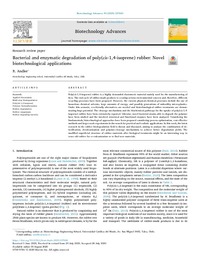Bacterial and enzymatic degradation of poly(cis-1,4-isoprene) rubber: Novel biotechnological applications
Autor
Andler-Osorio, Rodrigo
Fecha
2020Resumen
Poly(cis-1,4-isoprene) rubber is a highly demanded elastomeric material mainly used for the manufacturing of tires. The end-cycle of rubber-made products is creating serious environmental concern and, therefore, different recycling processes have been proposed. However, the current physical-chemical processes include the use of hazardous chemical solvents, large amounts of energy, and possibly generations of unhealthy micro-plastics. Under this scenario, eco-friendly alternatives are needed and biotechnological rubber treatments are demonstrating huge potential. The cleavage mechanisms and the biochemical pathways for the uptake of poly(cis-1,4-isoprene) rubber have been extensively reported. Likewise, novel bacterial strains able to degrade the polymer have been studied and the involved structural and functional enzymes have been analyzed. Considering the fundamentals, biotechnological approaches have been proposed considering process optimization, cost-effective methods and larger-scale experiments in the search for practical and realistic applications. In this work, the latest research in the rubber biodegradation field is shown and discussed, aiming to analyze the combination of detoxification, devulcanization and polymer-cleavage mechanisms to achieve better degradation yields. The modified superficial structure of rubber materials after biological treatments might be an interesting way to reuse old rubber for re-vulcanization or to find new materials.
Fuente
Biotechnology Advances, 44, 107606Identificador DOI
doi.org/10.1016/j.biotechadv.2020.107606Colecciones
La publicación tiene asociados los siguientes ficheros de licencia:


